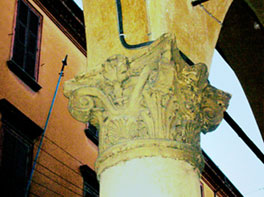|



 |
In 1506 Pope Julius 11 aroused the discontented people
against the Bentivoglio domination and restored the
legate authority above a Senate composed yet again of noble
men. This regime lasted for about three centuries, and made Bologna
the second most important town, after Rome, of the Papal States.
The fall of the Bentivoglio, brought about by their enemies, the Malvezzi,
took place in 1506. Their palace was destroyed by wave of violence, thus
producing the wellknown "Guasto" (ruins) from which the Via del Guasto and
the recently designed Giardino del Guasto, near the Municipal Theatre, get
their names; this was, in fact, the area were the "palazzo" stood, because
the present Palazzo Bentivoglio, at No. 8 Via Belle Arti, was built in a
later period, 1550-60, probably by Bartolomeo Triachini. At this point
Bologna lost all its autonomy and became the "second town" after Rome, the
capital of the Northern Papal States. In recognition of its new role Pope
Clement VII in 1530 crowned Charles V as Emperor of
the Holy Roman Empire in the St. Petronio church.
The Papal Court very often came to Bologna, (here, as early as 1515, Leon
X met Francis I King of France). Probably Luther saw here, not in Rome,
the curial pomp which finally convinced him to carry out the Reformation.
Following the Bentivoglio tradition in the first part of the XVI century
important "foreign" architects were invited to Bologna where they created
the first architectural examples which the future Bolognese architects
would follow.
The Palazzo dei Banchi, named after the bankers' shops it housed, was
brought to its present shape according to a project by Jacopo Barozzi,
called "11 Vignola"; it completed Piazza Maggiore hiding with its large
architectural span, the hovels built along the old market streets (Via
Pescherie Vecchie, Via Drapperie, Via Clavature);
access to these streets is through the arches of
the portico. Together with the Vignola - to whom the "palazzi" Bocchi (No.
21, Via Goito) and Boncompagni (No. 8, Via del Monte) are ascribed - other
great "foreign" architects working in Bologna in that period were:
Baldassarre Peruzzi, who planned the Ghisilardi chapel in St. Domenico
and, perhaps, the Palazzo Albergati at No.s 26 -28
of Via Saragozza; Giulio Romano, who, besides the project prepared for St.
Petronio left us the tomb of Lodovico di Boccadiferro in St.Francesco;
Andrea Marchesi di Formigine to whom the following works are ascribed: the
portico of St. Bartolomeoin StradaMaggiore, the Palazzo
Dal Monte. at No.s 3-5 of Via Galliera, the Palazzo Fantuzzi (in
collaboration with others) at No. 23 of Via St. Vitale, the Palazzo
Salina-Amorini, at No.s 9-11 of Via St. Stefano, the Palazzo Paselli at
No. 4 of Via St. Maria Maggiore. These "foreign" architects created
examples which the Bolognese architects would follow for future work in
the city, from the second half of the 16th Century.
Besides the palaces mentioned above, 15thCentury
Bolognese architecture can be noted in the following important buildings;
the Archiginnasio (see); in
Via Zamboni there
are the palaces
Malvezzi de' Medici , Salem Magnani , Riario, Poggi ); in Via
St. Vitale the Orsi.
|
|
 |
|
|
|
Related links
|
|
b
o
l
o
g
n
a
u
r
b
a
n
p
l
a
n
|
